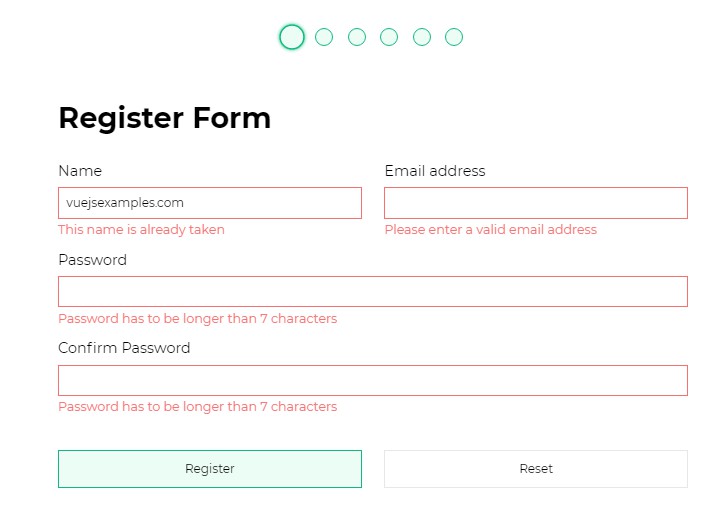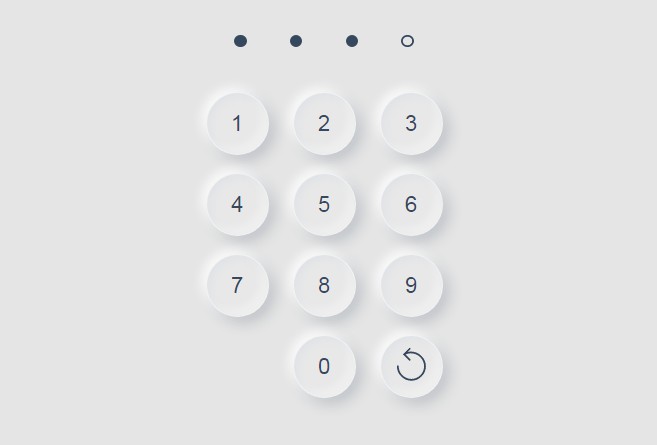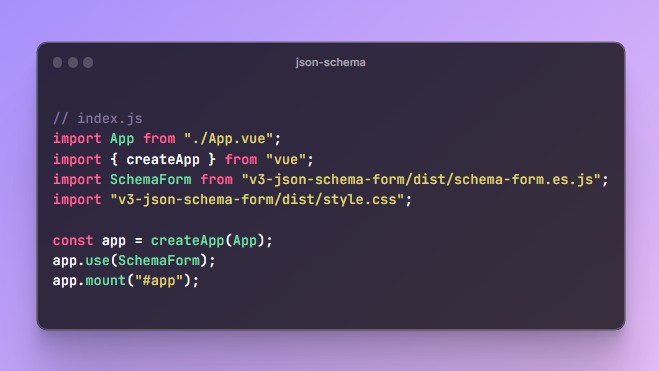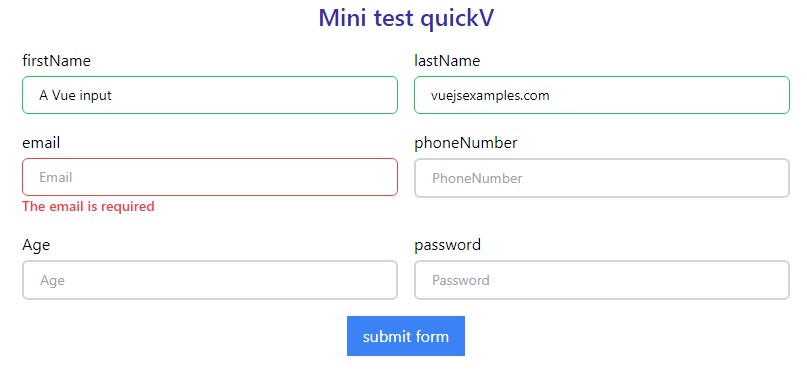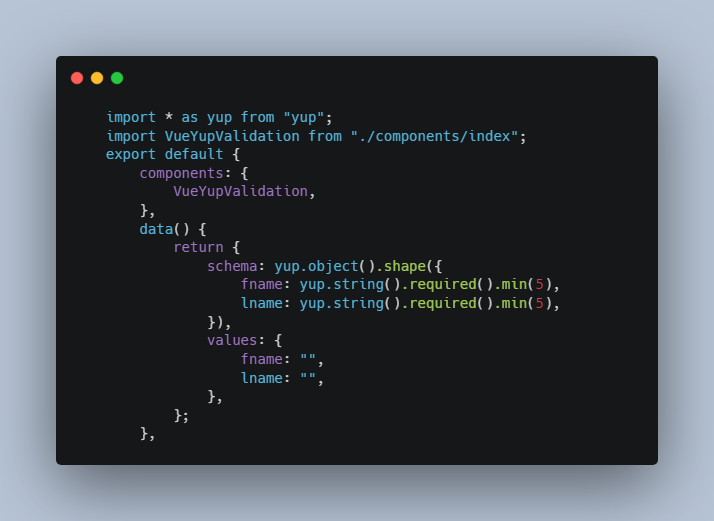Form Validation for Vue 3
Vue composition function for Form Validation.
- :milky_way: Written in TypeScript
- :ocean: Dynamic Form support
- :fallen_leaf: Light weight
npm install vue3-form-validation
Validation is async and is utilising Promise.allSettled.
API
This package exports one function useValidation, plus some type definitions for when using TypeScript.
const {
form,
errors,
submitting,
validateFields,
resetFields,
add,
remove
} = useValidation<T>(formData);
useValidation takes the following parameters:
formData- Type -
object - Description - The structure of your form data.
- Type -
The form data object has a structure that is similar to any other object you would write for v-model data binding. The only difference being that together with every value you can provide rules to display validation errors.
Let's look at an example how the structure of some form data object can be converted to an object with the addition of rules:
const formData = {
name: '',
email: '',
password: ''
};
// The above can be converted to the following
const formDataWithRules = {
name: {
$value: '',
$rules: [name => !name && 'Name is required']
},
email: {
$value: '',
$rules: [email => !email && 'E-Mail is required']
},
password: {
$value: '',
$rules: [
pw => pw.length > 7 || 'Password has to be longer than 7 characters'
]
}
};
The form data object can contain arrays and can be deeply nested. At the leaf level, the object should contain fields whose simplified type definition looks like the following:
type Field<T> = {
$value: Ref<T> | T;
$rules?: Rule<T>[];
};
To get better type inference while writing the useValidation function, it's recommended to define the structure of your data upfront and pass it as the generic parameter T. The type for the example above is pretty straightforward:
type FormData = {
name: Field<string>;
email: Field<string>;
password: Field<string>;
};
const { ... } = useValidation<FormData>({ ... });
useValidation exposes the following state:
form- Type -
object - Description - Transformed form data object.
- Type -
submitting- Type -
Ref<boolean> - Description -
Trueduring validation after callingvalidateFields.
- Type -
errors- Type -
ComputedRef<string[]> - Description - Array of all current validation error messages.
- Type -
Form is a reactive object with identical structure as the form data input
but with added metadata to every field.
Every object with a $value property will be converted to an object of the following type:
type TransformedField<T> = {
$uid: number;
$value: T;
$errors: string[];
$hasError: boolean;
$validating: boolean;
$onBlur(): void;
};
Given the structure of the previous example, this will result in the following:
type Form = {
name: TransformedField<string>;
email: TransformedField<string>;
password: TransformedField<string>;
};
As you may have noticed, all of the properties are prefixed with the $ symbol, which is to distinguish them from other properties but also to avoid naming conflicts. Below is a description of all the properties and their use case:
$uid- Type -
number - Description - Unique identifier of the field. For dynamic forms this can be used as the
keyattribute inv-for.
- Type -
$value- Type -
T - Description - The
modelValueof the field, which is meant to be used together withv-model.
- Type -
$errors- Type -
string[] - Description - Array of validation error messages.
- Type -
$hasError- Type -
boolean - Description -
Truewhile there are validation errors.
- Type -
$validating- Type -
boolean - Description -
Truewhile at least one rule is validating.
- Type -
$onBlur- Type -
function - Description - Function which will mark this field as touched. When a field has been touched, it will validate all it's rules after every input. Before it will not do any validation.
- Type -
useValidation exposes the following methods:
validateFields() -> Promise- Description - Validate all fields.
- Returns - A
Promisewhich will reject if there are validation errors, and resolve with the form data otherwise.
resetFields(formData?: object) -> void- Description - Reset all fields to their original value, or pass an object to set specific values.
- Parameters
formData?- Values to use when resetting (Sandbox).
add(path: (string | number)[], value: any) -> void- Description - Function for writing dynamic forms (similar to Lodash's set function).
- Parameters
path- The path of the property to add.value- The value to add. Objects with a$valueproperty will be transformed.
remove(path: (string | number)[]) -> void- Description - Function for writing dynamic forms.
- Parameters
path- The path of the property to remove. For exampleremove(['as', 0])will remove the first element in an array calledasat the root level.
Writing Rules
Rules are functions that should return a string when the validation fails. They can be written purely as a function or together with a key property in an object.
They can also alternatively return a Promise when you have a rule that requires asynchronous code.
Typing:
type SimpleRule<T = any> = (value: T) => any;
type KeyedRule<T = any> = { key: string; rule: SimpleRule<T> };
type Rule<T = any> = SimpleRule<T> | KeyedRule<T>;
Keyed rules that share the same key will be executed together. This can be useful in a situation where rules are dependent on another, such as the Password and Repeat Password fields in a Signup Form.
Rules will always be called with the latest modelValue, to determine if a call should result in an error, it will check if the rule's return value is of type string.
To prevent overly aggressive error messages, keyed rules will only be called
after all Fields with connected rules have been touched.
Because of the way the logical operators work in JavaScript, many basic rules can be written in one line:
const required = value => !value && 'This field is required';
const min = value =>
value.length > 3 || 'This field has to be longer than 3 characters';
const max = value =>
value.length < 7 || 'This field is too long (maximum is 6 characters)';
Async rules allow you to perform network requests, for instance checking if a username exists in the database. The same principle applies as for synchronous rules, resolve or reject with a string if the validation fails:
const isNameTaken = name =>
new Promise(resolve => {
setTimeout(() => {
if (['Alice', 'Bob'].includes(name)) {
resolve();
} else {
resolve('This name is already taken');
}
}, 2000);
});
Troubleshooting
- If you encounter errors while building, you may have to install a TypeScript version >= 4.1
